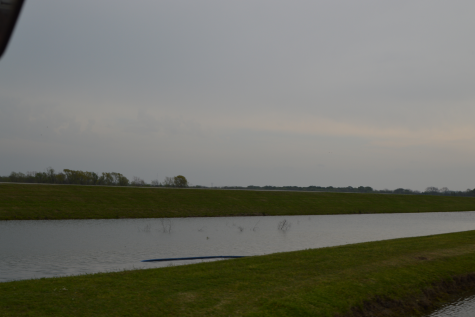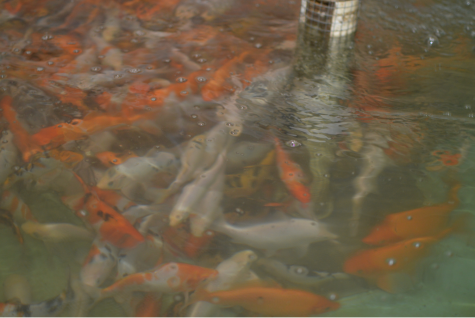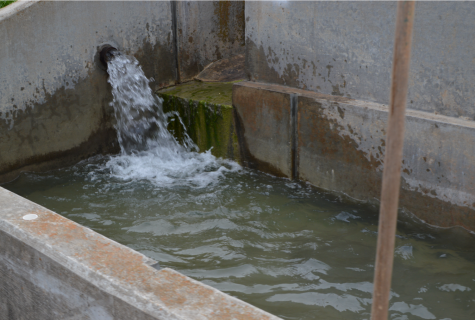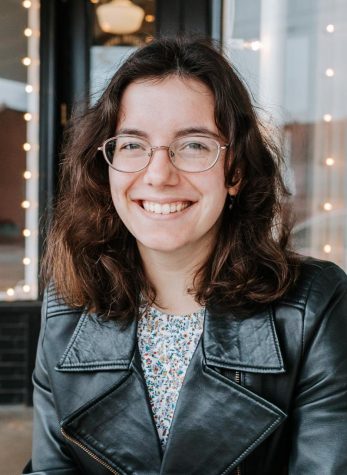Fish production at the Durant State Fish Hatchery
May 3, 2022
At the Durant State Fish Hatchery, one of the key factors in fish production are the different ponds that are divided into distinct groups called phases. There is Phase Zero, which contains 20 ponds; Phase One and Two, which are a dual series of 31 combined ponds in the central part of the hatchery; and Phase Three, a series of 32 ponds on the north side of the hatchery.
The different types of fish that are produced include white bass, brown trout, koi, sunfish, bluegill and catfish.
One of the major species of fish that the hatchery is known for is the largemouth bass; the northern subspecies of the largemouth bass is commonly found in Oklahoma, but the natural subspecies is in Florida. The mix of the two subspecies is common in the South and is known to grow to larger sizes than the original northern largemouth bass.

The hatchery was known for producing native game fish for farm ponds, but roughly 40 years ago, the striped bass production became more emphasized. This led to the Durant Fish Hatchery becoming the only producer of Florida largemouth bass in Oklahoma.
In the 1970s, the ODWC began introducing the largemouth bass’ genes into Oklahoma waters. Before the Florida bass genetics were introduced, the record number for a bass in Oklahoma was 9 pounds, but due to the genetics, the current state record for the largemouth bass is more than 14 pounds.
Each year, the adult bass fish that are in the spawning process – which is the fertilization of fish eggs – they are genetically tested to ensure that they are pure Florida bass, and in the month of April they begin to spawn.
There are certain techniques for specific fish that employees undertake in order to help the fish spawn. For the bass, the employees prepare their ponds by placing Bermuda grass squares on the bottom of the ponds to hold their eggs. After the eggs hatch, the bass fry is then moved to grow out of the ponds elsewhere, and once they grow to 1.5 inches, they are stocked into the Oklahoma lakes. In 2021 alone, the hatchery produced around 1.2 million bass.
Koi fish also have specific ways in how they spawn. In the pond, rye grass is grown for the koi fish to lay their eggs. They spawn in the shallows of the water and all the eggs stick to the grass to hatch.
There are still major developments that are occurring at the hatchery for the benefit of efficiency in fish production. The hatchery has started what they call the Catfish Barn, which contains a series of tanks and recirculation systems so the hatchery can slowly learn to produce more fish year-round rather than depend on the ponds in the seasons.
Most species are affiliated with warmer temperatures which means that most activity comes to a stop in the wintertime. This level of production year-round would be efficient and beneficial towards the hatchery and the public.
In the Catfish Barn, there are several tanks that accompany several types of fish: sunfish, warmouth, green sunfish and bluegill hybrids and koi fish. With the warmouth, their goal is to possibly create a whole pond for them to spawn to be forage fish, which means prey fish, for the bass. Since bass is the primary fish they aim to develop, the production of forage fish for them is important as well.
With the green sunfish and bluegill hybrids, around 2,000 have been produced in the tanks. These fish are mostly produced Close to Home program, which is a program that is meant to be for children whose parents do not have the resources to go fishing. This hybrid fish is an example of one that children can fish with.
“You want to get all the kids interested in it,” Wilder stated, expressing that an interest and a touch to nature is an important part of life.
Koi fish are also another type of fish produced at the hatchery. Technician Mark Wilder stated that the koi fish in the tanks are going to be spawners within the next year, and that the brute stock they have ranges from being at least 12 years old and weighs around 30 pounds.

Koi fish are highly priced and valuable as well due to the unique patterns on their bodies.
“These guys are cool though because you can kind of see the variability in all of them,” Wilder said. “We always kind of joke about it, but we use them for fish food, and you know internationally in the koi market there are some that sell for over $1 million.”
Wilder stated that the research system within the Catfish Barn is eventually going to be ran for all the fish tanks with a swimming pool pump – which is pretty common in the industry –but for trial purposes they are keeping it to where the system only reaches one tank. A biofilter also runs through the pump.
This biofilter contains two different types of bacteria including nitrobacteria. This bacterium converts all the nitrates that the fish produce in addition to all the leftover food that has been produced. A UV light within the system contains UV sterilization and it kills everything that is harmful such as viruses, parasites and bacteria.
There is also the heater/chiller, which moderates the temperature within the barn year-round according to the season. During the summer, the chiller comes into use when the building gets to around 108 degrees, and during the winter it is used as a heater. The end goal is to keep the fish’s temperature to be around 75 degrees.
One of the main pump stations at the hatchery has high importance because it pumps water back into the reservoir from what is drained from the ponds.
“It’s not much to look at, but it’s kind of the heart and blood of how this place runs,” Mark explained. “Without the moving water, not much really happens.”
The hatchery contains two reservoirs – one being five acres while the other is 15 acres. According to Wilder, what is pumped from the river after all the ponds are filled is lost in evaporation.
In addition to the reservoirs, there is also Phase Three of the hatchery. Phase Three was an original part of the hatchery, but one of the major changes they had to make was even it with the reservoir. According to Wilder, this is more energy consumptive than it should be, especially in the action of moving water back and forth.
“In the future, they would like to redo these ponds and make them lower so that way we could utilize these ponds along with Phases One, Two and Zero,” Mark stated.
According to Mark, they currently have various ponds that are beginning to fill because they are starting to move the koi fish into the ponds so they can spawn, then moved back into their holding tanks.
“We’ll raise the fry that they produce. They’ll raise up to about an inch-and-a-half, and they will be used for forage for the bass,” Wilder stated.
He said that they currently have ponds of hybrid sunfish, channel catfish and blue gill.
One of the problems that the staff faces once all the respective ponds are drained is picking through the mud puddles to find leftover fish. They also have to go back through and use specific equipment to level out the bottom of the pond so the surface is flat, and then it can drain the remaining water.
The next step is the harvest basin. Once the pond drains itself of water, it will go through an alleyway in between the ponds and drop into the basin. While the water is draining, so are the fish, and once everything reaches the harvest basin, the next step is to extract the fish from the water.

Trucks line up along the side of the basin with netting, and they continually fill the trucks to the brim before moving to the next one. Wilder stated that the process takes around 45 minutes, and that it is efficient. He further stated that the fish that are harvested then are transported to the Blue River in Oklahoma.
While a fish hatchery may not seem vital, they allow the growth of fish populations to feed people, provide commercial, economic benefits to the public and even give children opportunities to fish on their own. They also allow fish to have dependable homes and habitats rather than risk living in deconstructed or polluted habitats. The Durant State Fish Hatchery remains to be a significant part of not only Durant, but of the region as well.

